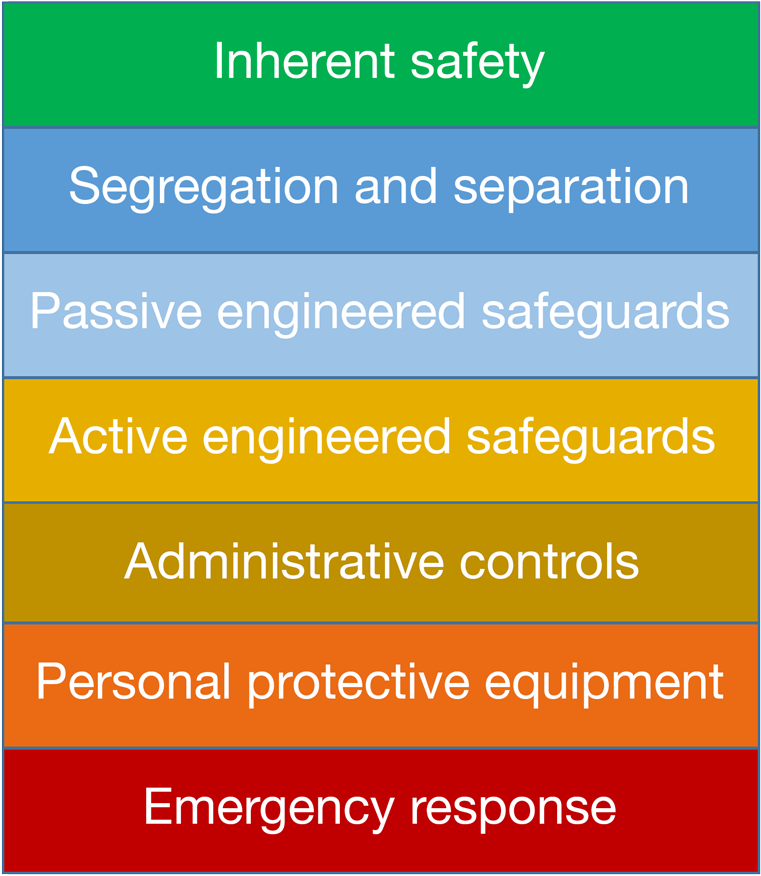Safer technology and alternatives analysis (STAA) refers to the selection of risk reduction measures using a hierarchy of hazard controls in which types are controls are ordered according to their reliability.

Inherent safety controls are preferred and occupy the top position in the hierarchy. Other controls, such as passive, active, and procedural, generally decrease in reliability and are less desirable.
The consideration of inherently safer technology (IST) and inherently safer design (ISD) is a key aspect of STAA. These concepts are means to eliminate or permanently reduce the hazards associated with materials and operations used in a process by making accidental releases less likely, or the impacts of such releases less severe.
The four major inherently safer strategies are:
Minimization: Using smaller quantities of hazardous substances
Substitution: Replacing a material with a less hazardous substance.
Moderation: Using less hazardous conditions or a less hazardous form, or designing facilities that minimize the impact of a release of hazardous material or energy.
Simplification: Designing facilities to eliminate unnecessary complexity and make operating errors less likely.
Passive controls use design features that reduce the hazard without human, mechanical, or other energy input, e.g. pressure vessel designs, dikes, berms, and blast walls. Active controls rely on mechanical or other energy input to detect and respond to process deviations, e.g. alarms, safety instrumented systems, and detection hardware, such as hydrocarbon sensors. Procedural controls are management measures such as policies, operating procedures, training, administrative controls, and emergency response actions to prevent or minimize incidents, e.g. administrative limits on process vessel fill levels and procedural steps taken to avoid releases.
The premise of STAA is that the management of process hazards may be capable of improvement through the implementation of inherent safety controls or risk management measures that are more robust and reliable than ones currently in use at the facility, either as replacements or as new additional risk reduction measures. Of course, any of the possible safer alternatives should be assessed to determine if they are achievable, practical, and cost effective, and that they don’t inadvertently transfer risks elsewhere that could either be unmanaged or undesirable.
STAA does not focus exclusively on inherent safety and the hierarchy of hazard controls philosophy. Risk reduction should consider a combination of strategies including defense in depth, also known as layers of protection, wherein multiple controls are used to protect against a hazard to guard against the failure of any one of them. Facilities typically utilize as many layers as necessary to adequately control their process hazards, with preference given to more reliable safeguards. Redundancy and diversity are also important design principles for controls to guard against single failures and common cause failures. The use of fault tolerant equipment that is capable of withstanding possible faults or deviations from design should also be considered, e.g. making piping and joints capable of withstanding the maximum possible pressure if outlets are closed.
These strategies typically are applied to a process throughout its life cycle from initial process design, through initial startup, to on-going operations and eventual decommissioning. Inherent safety controls are most effectively applied during process design but they can also be applied to existing processes.
STAA is performed in association with PHA studies, such as HAZOP, that identify hazard scenarios for processes and the possible need for risk reduction measures, that is, additional safeguards. The hierarchy of hazard controls, in combination with other risk reduction strategies, is utilized in selecting needed safeguards. The results of STAA should be documented.
Primatech can assist you with all your process safety needs. Please contact us for further information.


